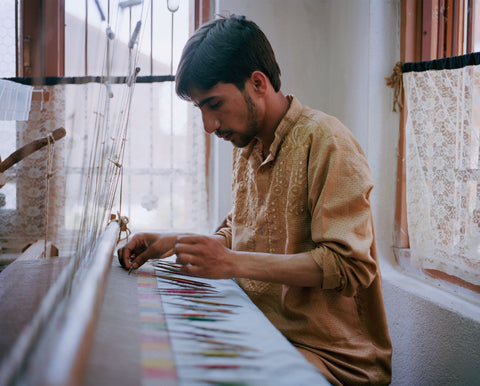Shawl Weaving in Kashmir

Shawls were either embroidered or woven using the twill-tapestry technique known as Kani for which Kashmir is world-renowned. In the tapestry technique a large number of bobbins, each loaded with yarn of a different colour, are used instead of a shuttle. Combined with the twill weave and using the finest yarns it creates an effect that is almost impossible to reproduce by mechanical means.


Embroidery had reached its zenith by the mid-nineteenth century. Known by the Farsi word sozani, which is a generic term for embroidery, it had developed an extensive and diverse design repertoire that utilizes a variety of stitches including darning and double-darning stitches, running, buttonhole, stem, satin, herringbone, knot and couching. There are two features that set Kashmiri embroidery apart from other embroidery traditions – one is the imitation kani stitch, a stem stitch reinforced by a very fine couching stitch and is known as the sozani stitch. The other is the use of scissors to cut the loose threads from the back of the fabric so that there are no floats visible on the reverse side of the fabric. For most embroidered shawls the designs are block printed onto the shawl using intricately carved walnut-wood blocks. The most praise worthy of embroidered shawls is the Dorukha shawl – it exemplifies both the craft of embroidery but also the ingenuity of the maker’s skill, as there is no right and wrong side evident. Taking this skill still further is the Dorunga Dorukha shawls, where the colours on both sides are also different.

The Kashmir shawl has been an item of luxury consumption all over India, west and Central Asia, as well as Great Britain and Europe since the sixteenth century. It became a fashion statement and a shawl was a prized gift brought home by many men returning from India. Little has changed, and the Kashmir shawl continues to be in vogue both in India and outside.
Credits:
Excert from Essay by Monisha Ahmed. Photography and Video Film by Zeze Collective directed by Errol Rainey and Isaac Wall
Monisha Ahmed is an independent researcher who has been visiting and writing about material culture in Ladakh since 1987. Her doctoral degree from Oxford University developed into the book Living fabric - Weaving among the Nomads of Ladakh Himalaya (Orchid Press, 2002), which received the Textile Society of America’s R L Shep award in 2003 for best book in the field of ethnic textile studies. She is the author of several articles on the material culture and textile arts of Ladakh, co-edited with Clare Harris Ladakh – Culture at the Crossroads (Marg Publications, 2005) and with Janet Rizvi authored Pashmina – The Kashmir Shawl and Beyond (Marg Publications, 2009). She is the co-founder and current Executive Director of the ngo LAMO (Ladakh Arts and Media Organisation) and is currently Associate Editor for Marg Publications, Mumbai.
